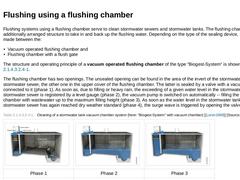
|
Flushing systems using a flushing chamber serve to clean stormwater sewers and stormwater tanks. The flushing chamber is an additionally arranged structure to take in and back up the flushing water. Depending on the type of the sealing device, a distinction is made between the: -
Vacuum operated flushing chamber and
-
Flushing chamber with a flush gate
The structure and operating principle of a vacuum operated flushing chamber of the type “Biogest-System“ … |
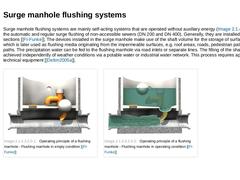
|
Surge manhole flushing systems are mainly self-acting systems that are operated without auxiliary energy (Image 3-72) for the automatic and regular surge flushing of non-accessible sewers (DN 200 and DN 400). Generally, they are installed in the starting sections [ [FI-Funke]]. The devices installed in the surge manhole make use of the shaft volume for the storage of surface water, which is later used as flushing media originating from the impermeable … |
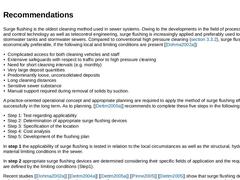
|
Surge flushing is the oldest cleaning method used in sewer systems. Owing to the developments in the field of process measuring and control technology as well as telecontrol engineering, surge flushing is increasingly applied and preferably used to clean stormwater tanks and stormwater sewers. Compared to conventional high pressure cleaning ( (High Pressure Cleaning)), surge flushing is economically preferable, if the following local and limiting … |
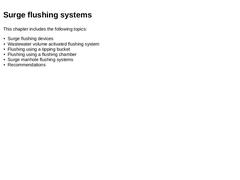
|
|
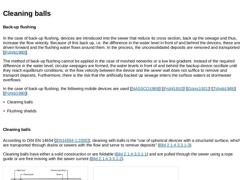
|
Back-up flushing In the case of back-up flushing, devices are introduced into the sewer that reduce its cross section, back up the sewage and thus, increase the flow velocity. Because of this back up, i.e. the difference in the water level in front of and behind the devices, these are driven forward and the flushing water flows around them. In the process, the unconsolidated deposits are removed and transported [ [Führb1980]]. The method of back-up … |
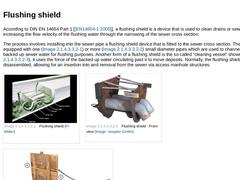
|
According to DIN EN 14654 Part 1 [ [EN14654-1:2005]], a flushing shield is a device that is used to clean drains or sewers by increasing the flow velocity of the flushing water through the narrowing of the sewer cross section. The process involves installing into the sewer pipe a flushing shield device that is fitted to the sewer cross section. The shield is equipped with one (Image 3‑77) or more (Image 3‑78) small diameter pipes which are used to … |

|
|
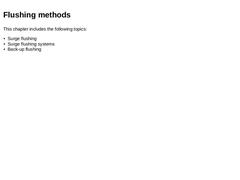
|
|
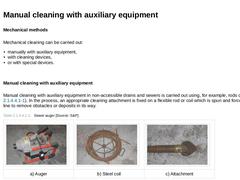
|
Mechanical methods Mechanical cleaning can be carried out: -
manually with auxiliary equipment,
-
with cleaning devices,
-
or with special devices.
Manual cleaning with auxiliary equipment Manual cleaning with auxiliary equipment in non-accessible drains and sewers is carried out using, for example, rods or coils (Image 3‑84). In the process, an appropriate cleaning attachment is fixed on a flexible rod or coil which is spun and forced through the line … |
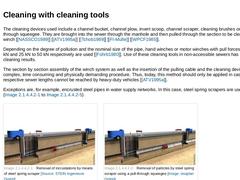
|
The cleaning devices used include a channel bucket, channel plow, invert scoop, channel scraper, cleaning brushes or a pull-through squeegee. They are brought into the sewer through the manhole and then pulled through the section to be cleaned using a winch [ [NASSCO1989]] [ [ATV1995a]] [ [Tchob1989]] [ [FI-Mülle]] [ [WPCF1985]]. Depending on the degree of pollution and the nominal size of the pipe, hand winches or motor winches with pull forces of … |
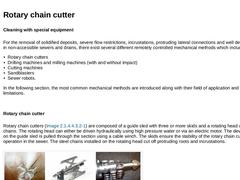
|
Cleaning with special equipment For the removal of solidified deposits, severe flow restrictions, incrustations, protruding lateral connections and well developed roots in non-accessible sewers and drains, there exist several different remotely controlled mechanical methods which include: -
Rotary chain cutters
-
Drilling machines and milling machines (with and without impact)
-
Cutting machines
-
Sandblasters
-
Sewer robots.
In the following section, the … |
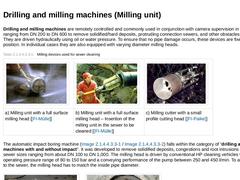
|
Drilling and milling machines are remotely controlled and commonly used in conjunction with camera supervision in pipe sizes ranging from DN 200 to DN 600 to remove solidified/hard deposits, protruding connection sewers, and other obstacles and roots. They are driven hydraulically using oil or water pressure. To ensure that no pipe damage occurs, these devices are fixed in a central position. In individual cases they are also equipped with varying … |
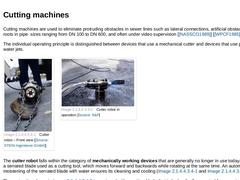
|
Cutting machines are used to eliminate protruding obstacles in sewer lines such as lateral connections, artificial obstacles as well as roots in pipe sizes ranging from DN 100 to DN 600, and often under video supervision [ [NASSCO1989]] [ [WPCF1985]]. The individual operating principle is distinguished between devices that use a mechanical cutter and devices that use pressurised water jets. (Image: Cutter robot – Front view ) (Image: Cutter robot in … |
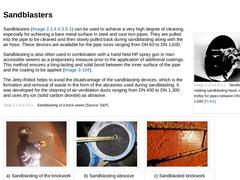
|
(Image: Sandblaster with rotating sandblasting head, and centring trolley for pipes between DN 350 and DN 1,600) Sandblasters (Image 3‑103) can be used to achieve a very high degree of cleaning, especially for achieving a bare metal surface in steel and cast iron pipes. They are pulled into the pipe to be cleaned and then slowly pulled back during sandblasting along with the air hose. These devices are available for the pipe sizes ranging from DN … |
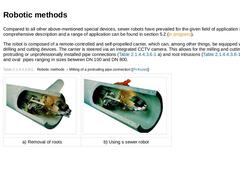
|
Compared to all other above-mentioned special devices, sewer robots have prevailed for the given field of application in practice. A comprehensive description and a range of application can be found in section 5.2 (in progress). The robot is composed of a remote-controlled and self-propelled carrier, which can, among other things, be equipped with milling, drilling and cutting devices. The carrier is steered via an integrated CCTV camera. This allows … |
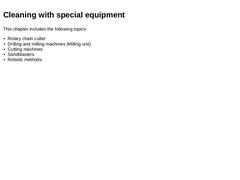
|
|
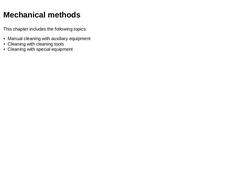
|
|
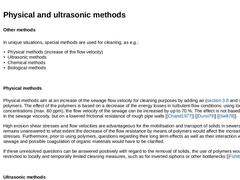
|
Other methods In unique situations, special methods are used for cleaning, as e.g.: -
Physical methods (increase of the flow velocity)
-
Ultrasonic methods
-
Chemical methods
-
Biological methods
Physical methods Physical methods aim at an increase of the sewage flow velocity for cleaning purposes by adding air ( (Cleaning of pressure lines) and (Cleaning of inverted siphons)) or polymers. The effect of the polymers is based on a decrease of the energy … |
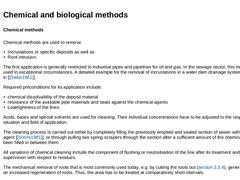
|
Chemical methods Chemical methods are used to remove -
Incrustations or specific deposits as well as
-
Root intrusion.
The first application is generally restricted to industrial pipes and pipelines for oil and gas. In the sewage sector, this method is only used in exceptional circumstances. A detailed example for the removal of incrustations in a water dam drainage system can be found in [ [Siebe1981]]. Required preconditions for its application include: |
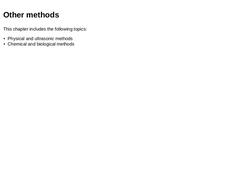
|
|
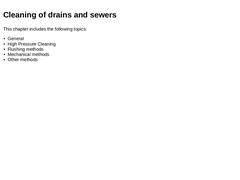
|
|
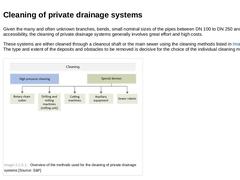
|
Given the many and often unknown branches, bends, small nominal sizes of the pipes between DN 100 to DN 250 and difficult accessibility, the cleaning of private drainage systems generally involves great effort and high costs. These systems are either cleaned through a cleanout shaft or the main sewer using the cleaning methods listed in Image 3‑109. The type and extent of the deposits and obstacles to be removed is decisive for the choice of the individual … |
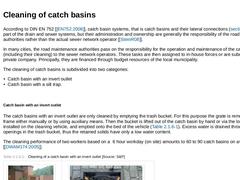
|
According to DIN EN 752 [ [EN752:2008]], catch basin systems, that is catch basins and their lateral connections ( (Drain systems)), form part of the drain and sewer systems, but their administration and ownership are generally the responsibility of the road maintenance authorities rather than the actual sewer network operator [ [SteinR08]]. In many cities, the road maintenance authorities pass on the responsibility for the operation and maintenance … |
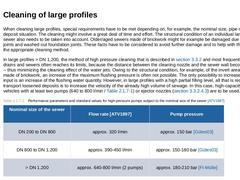
|
When cleaning large profiles, special requirements have to be met depending on, for example, the nominal size, pipe material and deposit situation. The cleaning might involve a great deal of time and effort. The structural condition of an individual large profile sewer also needs to be taken into account. Older/aged sewers made of brickwork might for example be damaged due to corroded joints and washed out foundation joints. These facts have to be … |
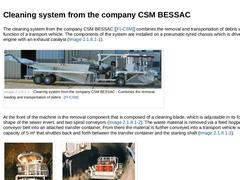
|
The cleaning system from the company CSM BESSAC [ [FI-CSM]] combines the removal and transportation of debris with the function of a transport vehicle. The components of the system are installed on a pneumatic-tyred chassis which is driven by a diesel engine with an exhaust catalyst (Image 3‑118). (Image: Cleaning system from the company CSM BESSAC) At the front of the machine is the removal component that is composed of a cleaning blade, which is … |